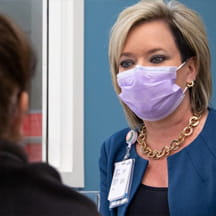The delta variant of COVID-19 has caused spikes in illness around the country as children comprise a growing proportion of cases. As of August 26, more than 22% of the 910,826 COVID-19 cases reported were children and adolescents—compared to a cumulative share of less than 15% of cases since the pandemic’s onset. While regions across the country are seeing increased reports of COVID-19 among children, Louisiana is an epicenter of a surge in cases.
Children’s Hospitals Today caught up with Mark W. Kline, M.D., physician-in-chief and chief academic officer at Children’s Hospital New Orleans and professor of pediatrics at Tulane University School of Medicine, to discuss how this current COVID-19 surge differs from previous waves of the virus and how children’s hospitals can prepare.
Describe the situation you’re seeing in your area with COVID-19 cases among children.
The Gulf South has been hit particularly hard. We've had quite a surge of COVID-19 cases that came on top of a summertime epidemic of RSV, and the two viruses at once have put a considerable strain on the health care system. What has been particularly striking to us with this surge of COVID-19 caused by the delta variant was the velocity with which it hit. It hasn’t been subtle.
About six weeks ago, we started to see a rise in hospitalizations from COVID-19. For several weeks, we had maybe one child in our acute care beds on any given day with COVID-19. In one week, we saw that number rise to 18—that happened over a six-day period.
For context, over the course of the entire pandemic, we never had more than seven children hospitalized at any given time with COVID-19. Suddenly, we had more than twice that number, and that evolved over a one-week period.
When all this started, our test positivity rate for children in our outpatient clinics was at about 1%. Fourteen days later, it was at 7%, 14 days after that it was at 25%, and that's where it has remained. That tells us there is an enormous amount of community transmission going on, and children are an important part of this epidemic.
The latest figures from the Louisiana Department of Health show 28% of all new cases in Louisiana are occurring among children and adolescents up to 17 years of age. This is quite a departure from what we'd seen with earlier surges and other variants of the virus.
One of the interesting aspects of this has been that many of the children we're hospitalizing both in our acute care and intensive care areas are very young. There are days when half of the children we have admitted for COVID-19 are less than 2 years of age.
Another important point involves which kids are getting sick. In the first year and a half of this pandemic, almost all the kids we had admitted to the Pediatric Intensive Care Unit (PICU) had a definable underlying condition that would predispose them to a severe disease. This time around, half the kids we've admitted to the hospital and to the PICU have not had any notable underlying problems. We've seen some very sick kids who were perfectly healthy until they got sick with COVID-19.
To what do you attribute this sudden—and in some cases, regionalized—surge of COVID-19?
The common thread among the hardest-hit states right now is low adult vaccination rates. In the case of Louisiana, when the surge started, just 37% of adult Louisianans were fully vaccinated against COVID-19.
If you looked specifically at adolescents between 12 and 17 years of age, the number was just 13%. Both of those figures, for adults and for adolescents, lagged behind the national numbers substantially. The low vaccination rate in Louisiana is appalling, and that's a big factor. We believe most of the children we're seeing in the hospital with COVID-19 were infected by unvaccinated adults in their immediate environment.
Kids are going back to school right now and thankfully our governor issued a mask mandate that includes the schools—all children 5 years of age and older, teachers and staff. We think that will mitigate what's been a surge on top of a surge over the next few weeks. We're grateful for that. When he announced this, I felt like we'd been thrown a lifeline.
What can children’s hospitals elsewhere do to prepare for surges?
They need to be doing some scenario planning around what things look like now and how they cope if they're at 1.3x what they are today in terms of census, and then 2x, and 3x, and 4x. That's the kind of planning we've done.
We instituted an incident command structure with a multidisciplinary team of leaders that meets daily and we've been doing that for a couple of months now. We handle everything from bed availability to pharmacy and medications, protective equipment, operations of the elevators, emergency department census, acute care and pediatric ICU census. We look over admission numbers, discharge times and discharges every day.
We've been through a lot of this planning, and we've still had to board patients in the emergency department for lack of a single bed—either in intensive care or in acute care. Looking forward, we’re thinking about the opening of schools and flu season, and we have done planning around what we are going to do—where can we find nurses and other staff and beds, if in December we're at 2x what we are right now. Hopefully, a lot of that scenario planning is for naught, but you never know.


